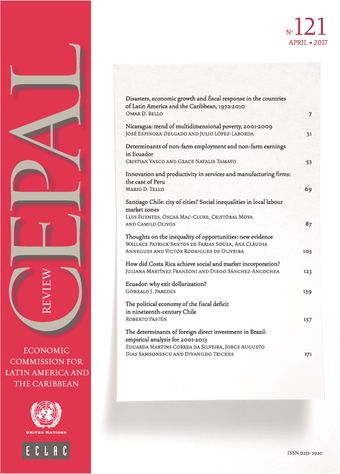-
The political economy of the fiscal deficit in nineteenth-century Chile: Roberto Pastén
- Source: CEPAL Review, Volume 2017, Issue 121, Oct 2017, p. 157 - 170
- Spanish
-
- 23 Oct 2017
Abstract
A structural shift in the trend toward higher deficits had emerged by the middle of the 1860s in Chile. For some authors, this was the result of increased spending owing to a fastgrowing economy. Another common explanation is the higher spending required to finance and then recover from the war against Spain, which began in 1864. This article provides an alternative explanation for the country’s fiscal disarray during that period, suggesting that it was motivated largely by increased political turmoil at the beginning of the second half of the nineteenth century in Chile that ended with the ousting of President Balmaceda in 1891. That period represents a dramatic departure from the calmer and economically buoyant early years of the Republic. Thus, it is suggested that the beginning of President José Joaquín Pérez’s rule in 1861 marks both a major political realignment after the birth of the Republic and a structural shift in the trend toward higher deficits. This hypothesis is consistent with the idea that political instability tends to lead to a decoupling of taxes from spending, two elements which would be otherwise aligned as predicted by the tax smoothing theory. This essay is a factual description in support of this hypothesis.





